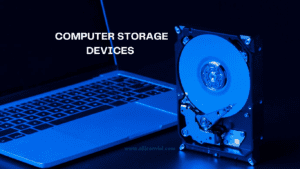Characteristics of Computer Storage Devices
Computer storage devices come with several important features. Firstly, they allow you to modify or replace data stored in memory, providing flexibility when requirements change, thanks to the mobility of these devices. Additionally, storage devices make it easy to manage data by being easily readable, writable, and rewritable. Accessing stored information is a straightforward process, as these devices don’t demand advanced skills for handling. The substantial storage capacity of these devices is a significant asset for computer systems, accommodating large volumes of data. Moreover, storage devices exhibit efficient performance, allowing seamless transfer of data between devices, contributing to the overall effectiveness of computer systems.
Flash Memory Devices

Flash memory devices have emerged as the preferred choice, displacing traditional magnetic and optical storage options. They offer user-friendly, portable, and cost-effective solutions for data storage needs. Their widespread adoption can be attributed to their accessibility and convenience.
One widely used flash memory device is the USB Drive, commonly known as a pen drive. These compact and portable devices come in varying sizes, ranging from 2 GB to 1 TB. Equipped with integrated circuits, USB drives facilitate easy storage and replacement of data, making them a versatile option for users.
Memory cards, another popular flash memory device, are commonly associated with smaller electronic devices such as mobile phones and digital cameras. They provide a compact and compatible solution for storing images, videos, and audio files. The convenience of portability adds to their appeal.
The Memory Stick, originally introduced by Sony, has become synonymous with efficient data storage. With the ability to store larger volumes of data, Memory Sticks offer quick and easy data transfer. Over time, various iterations of Memory Sticks have been released, catering to evolving storage needs.
Secure Digital (SD) Cards, available in mini and micro sizes, find applications in a range of electronic devices. Computers typically feature dedicated slots for SD cards; however, if not available, separate USB adapters are readily accessible. This adaptability ensures the widespread use of SD cards for data storage across various platforms.
